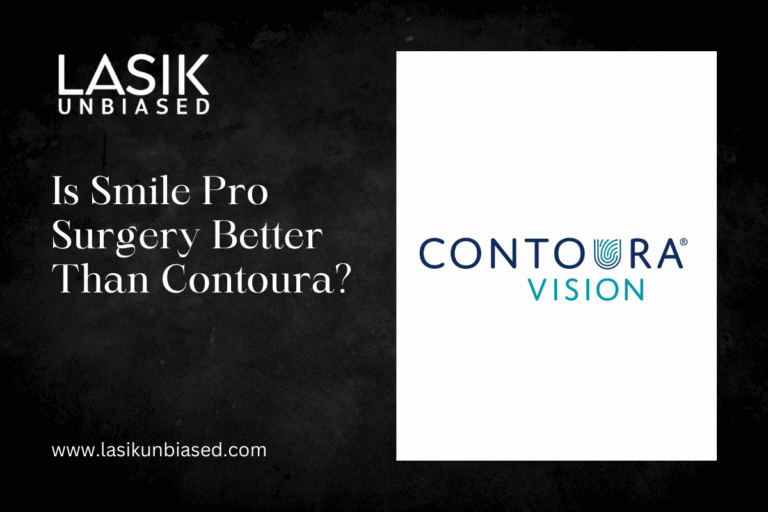SMILE Pro surgery and Contoura Vision are both advanced methods of laser vision correction, but neither can be universally declared “better” than the other.
The decision largely depends on individual factors such as eye condition, corneal thickness, and visual needs. Below, we’ll break down both procedures to help you understand their differences, strengths, and which may suit your specific requirements.
Understanding SMILE Pro Surgery
SMILE Pro surgery is a cutting-edge, minimally invasive procedure within the SMILE (Small Incision Lenticule Extraction) category. Positioned as an advanced evolution of SMILE, it utilises state-of-the-art technology, such as the ZEISS VisuMax 800 platform. This approach offers enhanced precision and faster recovery times compared to traditional LASIK, making it a compelling option for vision correction.
How Does SMILE Pro Surgery Work?
SMILE Pro involves creating a small lenticule (a thin, disc-shaped piece of corneal tissue) within the cornea using a femtosecond laser. This lenticule is then extracted through a small incision, which reshapes the cornea and corrects refractive errors.
Benefits of SMILE Pro Surgery
- Minimally invasive: Since the procedure involves a smaller incision (typically 2-4mm), it is less disruptive to the corneal surface.
- Quicker recovery: Patients often experience minimal discomfort and resume daily activities within a day or two.
- Reduced dry eye risk: The smaller incision helps preserve the corneal nerves, which reduces the likelihood of post-operative dry eye syndrome.
- Ideal for active lifestyles: The durability of the corneal structure after surgery makes it suitable for people with physically demanding jobs or active hobbies.
- Wide range of correction: Effective for treating myopia (short-sightedness), hyperopia (far-sightedness), and astigmatism.
Limitations of SMILE Pro Surgery
- More expensive: SMILE Pro surgery typically costs more compared to other laser eye correction procedures.
- Limited availability: While SMILE Pro is becoming more popular, it is currently offered at fewer centres and hospitals compared to LASIK, which has been around for a longer time.
Understanding Contoura Vision Surgery
Contoura Vision surgery is a topography-guided LASIK treatment designed to provide a customised approach to vision correction. It focuses on improving both refractive errors and corneal irregularities.
How Does Contoura Vision Surgery Work?
This procedure uses advanced topography-guided technology to capture detailed measurements of the corneal surface. A personalised ablation profile is then created and applied using an excimer laser to reshape the cornea.
Benefits of Contoura Vision Surgery
- Superior personalisation: Contoura maps over 22,000 points on the cornea, allowing for customised and precise corrections tailored to your eye’s unique shape.
- Improved vision quality: Many patients report sharper, clearer vision, even beyond 20/20 (achieving 6/6 or better in terms of visual acuity).
- Reduces visual disturbances: Treats conditions like glare, halos, and difficulty seeing at night more effectively.
- Addresses both refractive errors and corneal irregularities: Ensures overall improved eye health and vision.
Limitations of Contoura Vision Surgery
- Slightly invasive: Unlike SMILE Pro, Contoura involves creating a corneal flap, which may lead to temporary discomfort or a longer healing process.
- Higher dry eye risk: The corneal flap disrupts more tissue, increasing the potential for post-surgery dry eye symptoms.
SMILE Pro Surgery vs Contoura Vision Surgery
Here’s a side-by-side comparison to help you better understand the differences:
| Feature | SMILE Pro Surgery | Contoura Vision Surgery |
| Technique | Small Incision Lenticule Extraction | Topography-Guided LASIK |
| Corneal Incision Size | 2-4mm | Larger incision with flap creation |
| Recovery Time | Quicker, minimal discomfort | Slightly longer with mild discomfort |
| Customisation | Limited to refractive error correction | Tailored to correct both refractive errors and corneal irregularities |
| Treatment Range | Myopia, hyperopia, astigmatism | Myopia, hyperopia, astigmatism, and corneal irregularities |
| Dry Eye Risk | Lower risk due to smaller incision | Higher due to flap creation |
| Suitability for Active Lifestyles | Excellent | Good |
| Cost | Slightly more expensive | Slightly less expensive than SMILE Pro |
Which Surgery Is Right for You?
Determining whether SMILE Pro or Contoura Vision is better depends on several personal factors. Here’s how to decide:
SMILE Pro May Be Ideal If:
- You prioritise a minimally invasive procedure with a quick recovery.
- You are active or play high-contact sports that might strain your eyes.
- You’re at risk of experiencing dry eye syndrome.
Contoura Vision May Be Ideal If:
- You want a personalised correction that also addresses corneal irregularities.
- You experience nighttime glare, halos, or poor low-light vision.
- You’ve been told you’re not an ideal candidate for traditional LASIK due to corneal irregularities or complex eye measurements.
Questions to Ask Your Surgeon Before Choosing
Before deciding on either SMILE Pro or Contoura Vision surgery, it’s crucial to consult with an experienced refractive surgeon. Here are some important questions to ask:
- Am I a suitable candidate for SMILE Pro or Contoura Vision?
- What is my corneal thickness, and how does it impact the procedure suitability?
- Will my current prescription and eye health benefit more from one procedure over the other?
- Which procedure is better for my lifestyle and long-term vision goals?
- Are there any risks associated with these surgeries for my specific case?
Your surgeon can provide detailed guidance based on a comprehensive eye examination and evaluation.
Final Thoughts
While both SMILE Pro surgery and Contoura Vision offer innovative solutions for vision correction, the choice ultimately depends on your individual eye condition, lifestyle, and visual preferences. SMILE Pro leads with minimally invasive precision and suitability for active lifestyles, while Contoura stands out with its personalised approach and ability to address corneal irregularities for enhanced visual quality.
Every eye is unique, so choose the procedure that aligns with your needs. Consult an experienced surgeon to guide your decision and ensure a seamless experience.
If you’re still unsure about your options or need professional advice, book a consultation today to take the first step towards a clearer, sharper vision.


